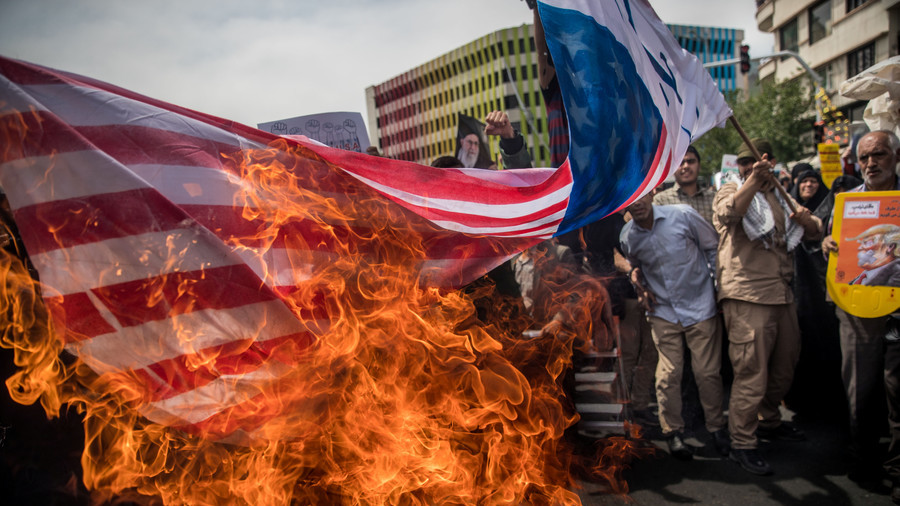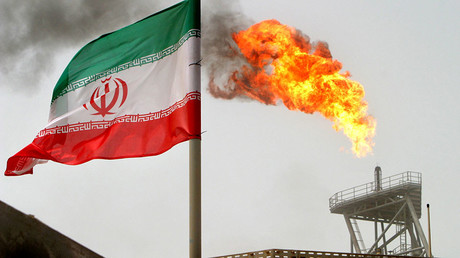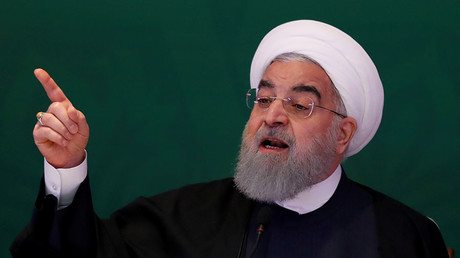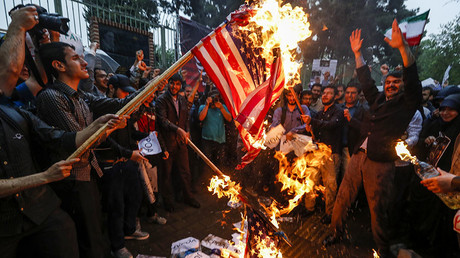Pull out of Syria? Bare all to IAEA? Why 12-point US list for Tehran is ‘ultimatum’ meant to fail

The US has laid out 12 demands for Iran that it says Tehran must meet for a new nuclear deal. Problem is, telling Iranian troops out of Syria and dictating what nuclear watchdog inspects doesn’t sound like a real roadmap for peace
US Secretary of State Mike Pompeo made the White House’s stance crystal clear Monday, calling the nuclear agreement between Tehran and six world powers a “loser.” President Donald Trump has already pulled the US out of the landmark deal earlier this month. A new deal should be drawn up, Pompeo asserted, while laying out 12 “basic requirements.” Many of those were predictable, such as requiring Tehran to “stop enrichment of uranium and never preprocess plutonium” – because obviously, the International Atomic Energy Agency (IAEA) is not good enough to hold Iran to its word.
One major point used as a bargaining chip is, however, entirely unrelated to the Iranian nuclear program. It reads: “Iran must withdraw all forces under Iranian command from Syria.”
The demand conveniently ignores the fact that Iranian troops were invited by the Syrian government and have been helping fight Islamic State (IS, formerly ISIS/ISIL) on the ground – while the US troops, stuck in Syria indefinitely, were not. “Nobody invited them there,”Russian Ambassador to the UN Vasily Nebenzya said in February, reminding the world that their presence was illegal. It’s not hard to guess which forces the Syrian government wants to keep and which it wants to be gone, as it battles the remaining pockets of Islamist militants.
Another US demand is that Iran must “respect the sovereignty of the Iraq government and permit the disarming, demobilization, and reintegration of Shia militias.” Just as in Syria, Iranian troops are in Iraq with the approval of Baghdad, and the country’s Popular Mobilization Forces (PMF) even receive funding and training from Iran and have been declared part of Iraq’s security apparatus. So why would Iranian troops suddenly need to disband and leave?
Then there’s the fact that the US seems to believe it’s perfectly fine to try to establish a new deal which abides by 12 demands designed by Washington – despite Washington being the sole party to withdraw from the original deal. The other signatories – the UK, France, Germany, China, and Russia – are still committed to the 2015 JCPOA.
Although the IAEA, tasked with inspecting Iran’s compliance under the deal, has repeatedly stated that Tehran is implementing its commitments, the US apparently distrusts international watchdog’s expertise. That’s according to the list of demands saying how the Iranian nuclear program should be inspected.
“First, Iran must declare to the IAEA a full account of the prior military dimensions of its nuclear program, and permanently and verifiably abandon such work in perpetuity. Second, Iran must stop enrichment and never pursue plutonium reprocessing. This includes closing its heavy water reactor. Third, Iran must also provide the IAEA with unqualified access to all sites throughout the entire country,”boomedPompeo, speaking Monday at the Heritage Foundation, a right-wing Washington think tank.
One may almost forget the IAEA is not a lapdog of Washington, but an international body. Why the US now gets to decide the scope and methods of its work is unclear.
Of course, there is also a whole array of demands to scale back Iranian military programs and alleged support of militant groups. US accuses Iran of sponsoring terrorism, including by helping the Palestinian group Hamas and even, allegedly, Taliban and Al-Qaeda. That these groups are overwhelmingly Sunni while the Iranian government in Shia is overlooked, by accident or deliberately.
The mentioned “threatening behavior against its neighbors,” the “firing of missiles” and “destructive cyberattacks” strangely mirror Washington’s own actions in the region, including some that have been aimed against Iran.
Crucially, there’s little doubt that the Trump administration understands Iran would outright reject most, if not all, of the listed demands, which brings the purpose of the entire list into question.
“Secretary Pompeo’s speech has not demonstrated how walking away from the JCPOA has made or will make the region safer from the threat of nuclear proliferation, or how it puts us in a better position to influence Iran’s conduct in areas outside the scope of JCPOA. There is no alternative to the JCPOA,” EU foreign policy chief, Federica Mogherini, said Monday commenting on Pompeo’s list. Others said the US list was outright destined to fail – on purpose.
“I think ultimatum is the right word… When you deliver an ultimatum, its purpose is to have it rejected,” former US diplomat Jim Jatras told RT. “There are people in the Trump administration, who want the regime change in Iran – it’s that simple, and they want Iran to reject their terms.”
Jatras believes it’s too early to tell at this stage if US threats against Iran are merely “noise” and pressure tactics like the one used against North Korea, but he says even that pressure could backfire and serve as a positive effect for Tehran by“forcing the Europeans to pull even farther away from the US than they have.” The worst case scenario, he says, is Washington proceeding with a unilateral military action aimed at regime change.
“As you can imagine, Iran will not agree to any of Washington’s demands,” Hamed Mousavi, professor of political science at the University of Tehran, told RT. “It is Iran that should be asking the US why it has not fulfilled its side of the agreement when Iran has fully complied with its obligations under the nuclear deal. Why should Iran negotiate with an administration that is not abiding by an international agreement that is the result of years of intense diplomacy?”




0 Comments:
Post a Comment
Subscribe to Post Comments [Atom]
<< Home